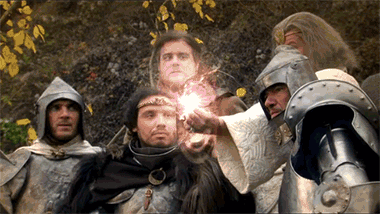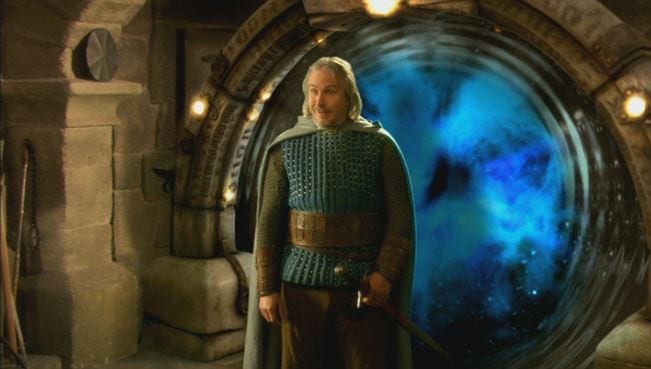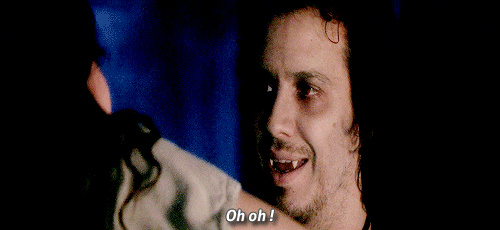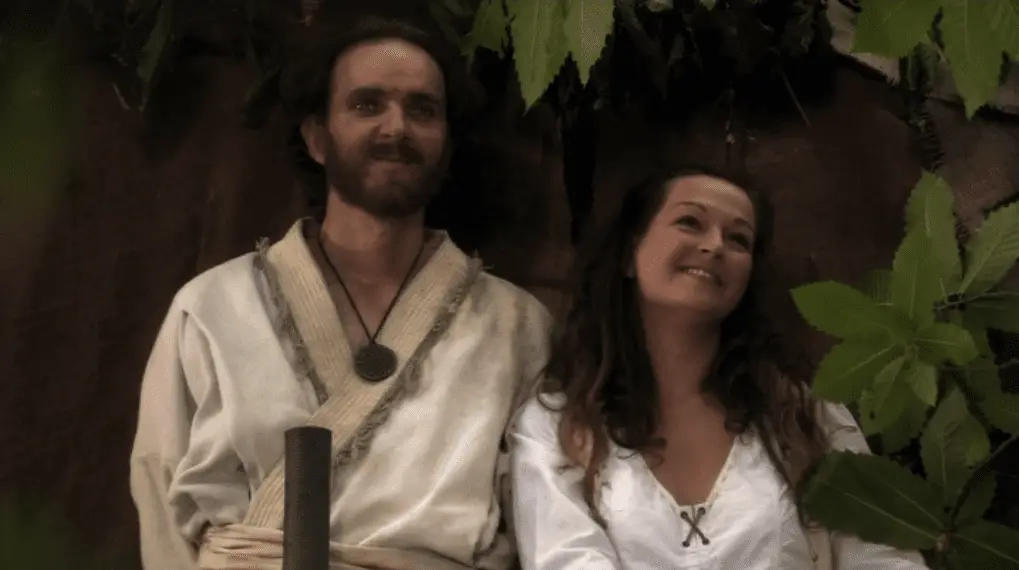Kaamelott is a 6 seasons TV-show that aired on M6 from 2005 and 2009. It is a humorous version of the Arthurian legend, but most importantly it is the best French TV-show ever. That’s my personal opinion of course but also a widely shared one in France. After all, even the English wikipedia page states that Kaamelott “is widely regarded as one of the best, most iconic, and most popular French TV series of all time.” To give a more enlightened opinion than mine and the one of everyone I know, John Howe—famous illustrator and chief conceptual designer of the Lord of Rings trilogy—said that he “find(s) it brillant.” So yeah I do have argument from authority in attention to the fundamental belief that I am right.
Kaamelott is a little jewel of television, which wasn’t a small task to accomplished. First, Kaamelott is a comedy, which doesn’t help give it an image of being a serious show. Second, it is a doubly nerd experience. Not only did Kaamelott adapt Arthurian legend (which, in a country whose critics have an issue with fantasy, is already a challenge) it also references roleplaying games and pop-culture.
Yet Kaamelott found popular and critical success. To the point that it is now corner stone of French pop-culture.

However, Kaamelott isn’t just this big goofy fest that gives you funny quotes for the rest of your life. It is also a show that dealt with pretty serious and heavy subjects. Its tone is slightly darker with each passing season, culminating with the attempted suicide of Arthur. Here at The Fandomentals, we talk a lot about grimdark and how it’s current fashionability is often boring, borderline ridiculous, and especially cringey when it is used to justify the “seriousness” of the cultural production in question. So seeing a comedy getting darker, grittier, and more serious might discourage some people.
One might think, “Another show that wallows in darkness far away from its original roots that made it popular?” Well, not really. Yes, Kaamelott went dark, but it went dark for all the right reasons. And it didn’t forget itself in the process.
Kaamelott “Story”
Books 1 to 3
Here, I am going to talk more about the principle of Kaamelott rather than its plot. Indeed, at least for the first two books (the two first seasons), the show doesn’t follow a precise plotline. There is no grand narrative leading from point A to B. Book 3 does start to include a “real plot” that slowly evolves toward Arthur falling in love with Lady Mevanwi and Lancelot completely leaving Kaamelott with Guinevere following him. However, there are still a lot of episodes absolutely non-related to this plot.
Indeed, at this point Kaamelott mainly presents comical snippets of the daily lives of Arthur, his knights, and his court. Those snippets aren’t directly related to each other. The characters acknowledge the existence of past events that happened in previous episodes, but you as a watcher will nearly always be able to understand what is happening without knowledge of the previous episodes.
Moreover, from book 1 to book 4 the average length of an episode is 3 min 30 seconds (there are 100 episodes per book). Each episode contains its one setup and punchline. Often, the introduction will have a situation that deepens the setup or foreshadows the entire joke.
So here are the main elements that makes the story of Kaamelott in the first seasons:
- Kaamelott is a recently built castle whose construction was supposed to unite the country and be a homebase for the quest of Holy Grail.
- Arthur and Guinevere’s marriage is a political match that Arthur stubbornly refuses to consummate. He has several mistresses that Guinevere always tries to befriend.
- Arthur has depression.
- With the exception of Lancelot and Leodegrance, all the round table knights are very bad at being knights. Most of them are also really stupid.
- Merlin is a very bad enchanter and is also pretty stupid.

- There are often barbarians (Vikings, Burgundians, etc.) trying to invade the Kingdoms. Sometimes Kaamelott fights against Romans too.
- The peasantry often comes to complain. The two leaders mortally hate each other.
- The knights go on quest in dungeons to bring back treasures. Those quests might be linked to Christianity or to Celtic imagery.
- Not everyone is Christian (for example, Percival will only be baptized at the end of book 4).
Book 4 to 6
Book 4 deals with the consequences of what happened in book 3. The rivalry between Arthur and Lancelot, now fully independent from any authority, is slowly destroying Kaamelott. The trust of the gods in Kaamelott is badly damaged by the Guinevere-Mevanwi affairs. In consequence, they send bad omens and banish the Lady of the Lake to a mortal form. A strange figure clocked in black is noticed to turn around Lancelot. However, despite being more plot heavy than the previous books, it still keeps the 3 min 30 second format.
Things change for books 5 and 6. Book 5 is composed of 8 episodes of 50 min (also screened as 50 episodes of 7 min… Thanks M6). In it, Arthur loses Excalibur and Kaamelott continues to fall to pieces. Finally, Arthur tries to kill himself after having discovered his infertility. Book 6 deals with Arthur’s young years in Rome and how he became king. It also presents the aftermath of his suicide attempt. It is composed of 9 episodes of more than 50 min. In short, it completes the near total tone shift of Kaamelott.
Humor
As you might have guessed from the my little presentation of Kaamelott‘s main elements, a good chunk of its humor relies on the fact that 70% of the characters are stupid. 10% more are not the sharpest tool in the box, but put under favorable light they will shine. But still, Kaamelott relies on absurd situations brought about by the utter stupidity of its cast.
However, it also relies on a vast array of tropes. For example, there are references to pop culture. I have already talked about the roleplaying game vibe of the quest system, but that’s not all. There are also direct reference to other cultural productions (Stargate, Star Wars, etc).

There’s a lot of of playing around with anachronism. Arthur is a very modern thinking king but the world around him isn’t. Also, Bors wants to spend Kaamelott’s budget on education and cultural programs while Leodegrance insists on spending it on war engines, mimicking the stereotyped cultural/security dichotomy attributed to the left/right political parties of France at the time.
There is also a lot a running gags. Percival trying to explain an insanely complicated board game to someone. Percival trying to explain his quests to the round table. The peasantry complaining, etc.
Kaamelott, in addition to using absurd humor, is also insanely well written. The dialogue is exquisitely funny and delivered in a resolutely modern language. The show also relies on the Arthurian mythos and the theories around it. For example, to explain the many different versions and names of the legends, the show has Percival giving the wrong name to people he saved. There are also jokes taking inspiration from classical culture, too (Guinevere and The Trojan Women).

Serious Subjects
The fact that Kaamelott is a big comedy doesn’t prevent it from talking about important subjects. I know that a lot of people aren’t comfortable with comedy dealing with serious matters but I disagree. Comedy will always by a premium medium to present important issues to the majority. And that is in part what Kaamelott does.
It talks about loneliness, depression, inequality, what the powerful should do, and more. The entire Lancelot and Arthur conflict is fueled by their opposing views on merit. Lancelot thinks that the quest of Grail should be the privilege of an elite and that is why it isn’t making any progress at the moment. On the contrary, Arthur believes the quest is meaningless if it doesn’t incorporate everyone and thinks it is the duty of the “elite” to welcome the less talented.
Guinevere and Lancelot’s relationship turns abusive, but it is never framed as a punishment for Guinevere. Guinevere left Arthur, who couldn’t and wouldn’t make her happy, to be with someone who actually valued and loved her. That this love turned out abusive isn’t her fault and neither the narrative nor Arthur frames it that way.

The importance of good parenthood (and not always related to blood ties) and its difficulty are talked about. The need for respect is also something that came back often through Percival and Guinevere. There are a lot of other serious themes tackled by Kaamelott and I won’t talk about all of them. The important this is that they are here. The watchers who aren’t looking for them while ends up dealing with them as the narrative does. Even if they don’t realize it.
And Kaamelott has been dealing with these themes since the beginning of the show. In my opinion though, they found their culmination when the show started to get darker.
The slide toward a darker Kaamelott: What happened
First, I want to say that Kaamelott never completely departed from humor. Even during its darkest moments the show kept on offering jokes. In the very last episode, Arthur’s aunt explains him that they all thought that this time he wasn’t about to wake up (one years after his attempted suicide Arthur is still bedridden and barely better). Therefore, she and his mother have sent the invitations for his funeral. However, Arthur is alive and the guests are here now. To that Arthur answers,
What do you want me to do? Off myself and try to not miss this time?
Sure, it is not always light jokes but the show never aims to makes you cry all the time.
That being said Kaamelott, started getting darker in book 4. There was even a prophecy explaining that things would get very very dark. This change was foreshadowed by some episodes as early as book 1. It is a blink and miss foreshadow because these episodes are still extremely funny, but it is there. The humor was more bitter than usual.
Still, things definitively changed when Arthur went out of the path fixed by the gods. You see, Arthur is a hero and heroes are supposed to be selfless. At the time he wasn’t, because he was getting extremely lonely, and that led to catastrophe.
There are things that, after being treated in a comedic setting for years, needed to be brought back to their deeply sad roots. Sure, you can joke about depression and loneliness but depression and loneliness are not funny. Nor is his betrayal, nor is the end of love or years of disrespect. So Kaamelott sets out to explain its origin and its end in a rather tragic tale.
As such, book 5 is Arthur’s final and most intimate quest. It still hasn’t completely transitioned to nearly a serious tone but the end is tragic. Book 6 spends 75% of its running time presenting the very bitter beginning of Kaamelott.
Where it Failed
Book 6 is full of hits and misses. There are moments that, during my rewatch, made me deeply emotional. However, I must concede that not everything that should have made me emotional did.
For me a symptomatic case is Arthur’s first marriage. You see, in Kaamelott, Arthur marries for the first time in Rome to a noble Roman woman. He is supposed to be very in love with her. Having to leave her behind to assume his destiny is the first blow that will lead him to despair. Unfortunately, despite 8 episodes out of 9 in a book mainly focused on Rome, I did not see that love. I saw desire between the two sure, but the great love spoken of was never there. There was not enough focus, or the focus was not used well enough, to make this big emotional relationship believable for the watcher. On the contrary, the relationship between Arthur and the Emperor, with less screen time, is more impactful.

The lack of budget also started to be an issue. An epic period drama is something that requires a lot of money. I don’t think Kaamelott ever had this kind of money. For a comedy, that is perfectly okay. I don’t mind that all the monsters and battles are off-screen, for example. I am not here for that, I am here for the jokes. In addition, thanks to a real attention to detail and real vision, Kaamelott always ended up making goods things with their sets and costume. However, with scenes such as the lighthouse burning down, or the lack of diversity in costume of the rich romans, the lack of budget started to be seen. It was passable, but Kaamelott was never a show that had stopped at “passable” before.
Why it works
Despite the several misses of book 6 (and some in book 5 too) the tonal shift in Kaamelott works. It works because first it wasn’t done to appeal to an audience wanting grittier stuff. Quite the contrary actually. It was a big bet at the time. No, it works because this tonal shift was done to uphold the Kaamelott narrative. Kaamelott wasn’t a comedy, it was a tragicomedy from the very beginning.
Kaamelott went darker like it always promised it was going to do. It is the adaptation of an epic and Astier (creator, writer, director, and main actor) wanted all of us on board with this epic. In the end of book 5 Arthur makes this speech that I find incredibly meta so I am going to quote it here (translation by me):
I did built a fortress. For the Grail, I built a fortress. It is called Kaamelott. And I went to find knights in all the Kingdom: in Caledonia, in Cameliard, in Gaunnes, in Vannes, in Whales. I asked for a big table to be made so the knights could sit together. I ask for it to be round so none of them would have to seat in the corner or at the end of the table. It was complicated, I tried to explain what the Grail was so everyone would understand. It was hard, I tried to laugh so no-one would get bored. I failed but I don’t want anyone to say that I didn’t do anything because it is not true.
Astier wanted to tell a tale of heroism with Kaamelott. Is heroism possible if your hero doesn’t face darkness? I don’t think so. Arthur faces deeply personal darkness and hits rock bottom. But this will make Arthur’s future heroism, his return, only more brilliant. Because Kaamelott doesn’t end on a depressing note, it ends with a deeply hopeful one.
Arthur is back in Rome and is training again with a wooden stick. The scene is cut with flash backs of him as a four-year-old playing in the snow with Excalibur after having pulled it out for the first time. It is the first positive framing of his destiny we have seen in two seasons. Finally, a text appears before the final episode closes: “Soon Arthur will be a hero again.”

So yeah the tone shift worked so well that we have all been waiting for a Kaamelott movie for ten years now. What a win!
Conclusion
Kaamelott went from being the funniest show ever aired on French TV to a bittersweet, tragic tale in its last seasons. Yet, that shift only made the show more iconic. It is because this shift helped the narrative and brought the show to new highs. It was never done for shock factor and was always respectful of its character and therefore of its audience. That’s why, ten years later, Kaamelott is still iconic. Why Astier can still finish his story and why I am writing this piece.
Considering that Kaamelott is entirely and legally available on youtube outside of France (partially subtitled in English), I can only advise you to watch it. You will laugh a lot, and maybe cry a little too.

